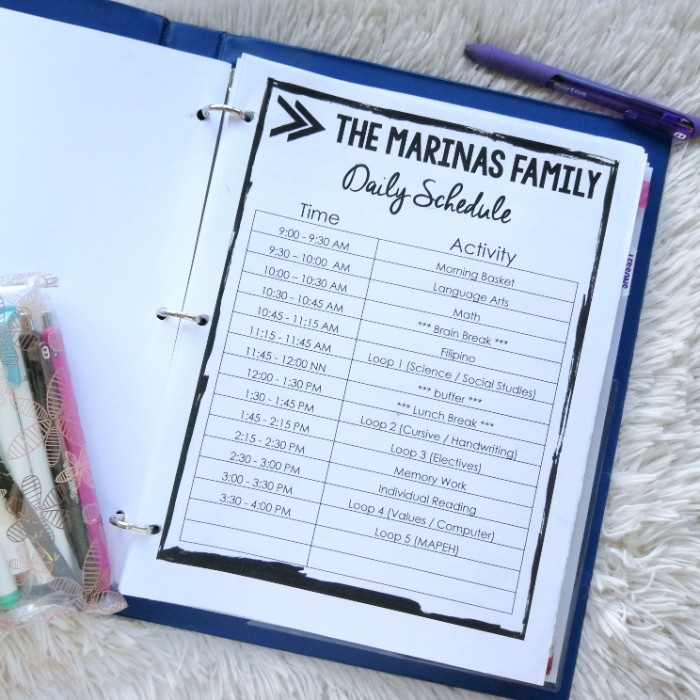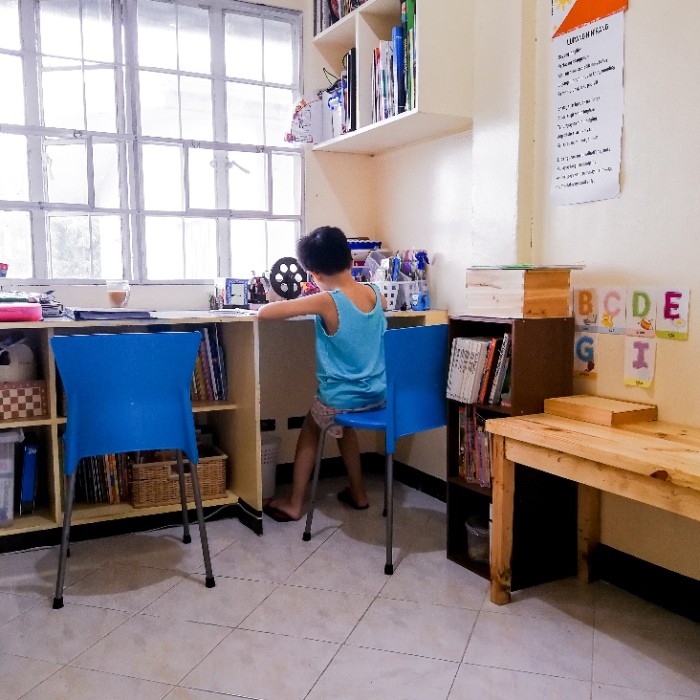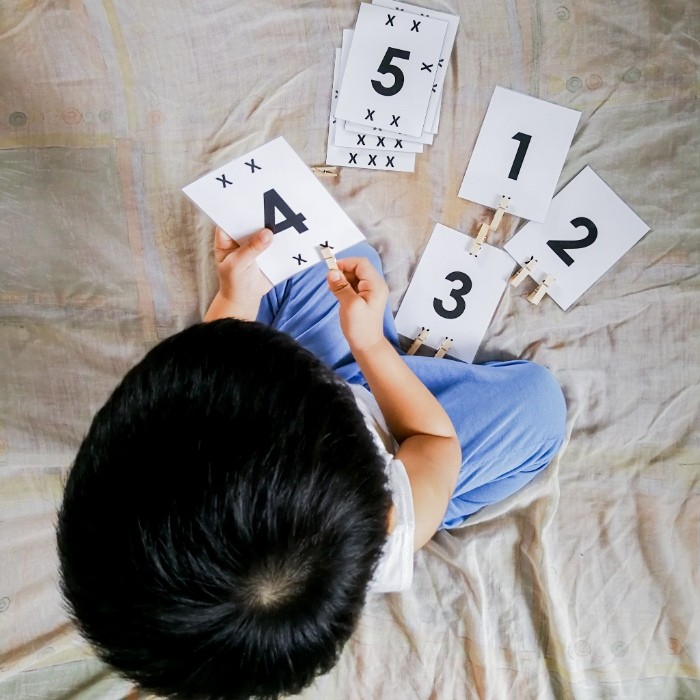One of the things I had to think about when we first started homeschooling was how to structure our day so that we can accomplish whatever we set out to do. I’m a natural planner and organizer and it’s important to me to have a guide so that we don’t feel lost or waste our time.
Since then, our homeschool routine has changed several times depending on the season of life we were at. Take note though that I use the term “routine” instead of schedule. I just think that a schedule with specific time slots is something that will not really work out for us. I don’t like being too strict with that because we don’t typically wake up at the same time every day. However, a routine or sequence of actions, is something more doable for us because we can still follow it no matter what time we start our homeschool day.
Our Daily Homeschool Routine
To better explain what I mean, here’s a copy of the homeschool routine we’ve been following this school year.

As you can see, I listed down all the subjects or activities that we plan on accomplishing in a day. I did list down time slots too. However, those just serve as a guide to remind me how long each subject or activity should last. We don’t necessarily start at 9:00 a.m. all the time. Some days it could be earlier and other days it could be later. What’s important for us is to be able to know which activity comes first and which ones come next so that we know what to expect. Our kids thrive on routine.
Our homeschool routine is really a combination of a morning routine and an afternoon routine. Our mornings are composed of our Morning Basket and our major subjects, with one short break in the middle. Then, we take a break for lunch. Our afternoons are more relaxed and composed mostly of minor subjects and independent work. The goal is to end by 4 p.m. or earlier so that my son can still have some time for free play before dinner.
You will also see Loop sections in our routine. A loop schedule basically means alternating subjects that you don’t need to take every day. For instance, for Loop 1, we alternate between Science and Social Studies. If we do Science today, that means we’ll be doing Social Studies tomorrow.
We’ve been following this routine for 8 months now and it’s been working well for our family. At this point, there’s no need for us to change things up yet. Next school year could be different though.
Tips on How to Create Your Own Homeschool Routine
If you’re trying to create a homeschool schedule or routine of your own, here are a few tips to consider based on my own experience.
Plan according to your lifestyle.
Each family’s lifestyle is different which means that our homeschool schedules will look different from each other as well. What works for us might not work for you. The important thing is for you to find the best fit for your family.
Our family involves two parents who work from home with two kids full time, one of which is a 3-year-old. My husband has a fixed work schedule while mine is more flexible. This means that when my husband is working, I’m the only one who can focus on child care and chores. So, I needed to find a homeschool schedule that can work around that and still leave me some time for work.
In our case, scheduling all our major subjects in the morning leaves me time after lunch to put my youngest, Zander, down for a nap. My 8-year-old can work on independent tasks such as his cursive and typing practice while waiting for me to be available again. Aiming to finish everything by 4 pm also leaves me time to do chores before dinner and work after dinner.

Remember that a typical homeschool day may not take as long as a regular day in private or public school.
Most of us parents most likely grew up in a traditional school setting, and so we might tend to copy that in our homeschool. However, we should remember that a lot more can be accomplished in one homeschool day in less time. This is because there is less administrative work involved for the teacher and less students to teach as well. Homeschool parents are also able to spend more one-on-one time with their kids which enables them to get more work done faster.
You’ll notice in our schedule that we only take 30 minutes per subject. I decided on this after learning about the Charlotte Mason approach which advocates short sessions because kids tend to have shorter attention spans.
You might think that 30 minutes is way too short but we can actually get a lot done in that span of time. In case my son doesn’t finish his work within the 30 minutes alloted for that subject, I just let him continue it the next day and we move on to the next activity. This set up is perfect for him because he gets bored easily.
Consider your child’s personality.
Are your kids early risers or do you have a hard time getting them out of bed in the morning? Consider this in figuring out what time to start school and which subjects to do first. The same goes for you too as the homeschool parent.
You need to be strategic in terms of when to schedule certain subjects. Be aware of when your kids are more alert and active. Use that time to schedule subjects that require the most effort or focus.
For instance, I know that my son, Ziggy, works best in the mornings after breakfast. So, I schedule all our major subjects then. That way, if that’s the only thing we accomplish for the day, it will be all good.
I also know that I’m a night owl and would often still be working or doing something until 1 or 2 am. That means, I can never start school very early in the morning.
Factor in siblings.
It’s a bit trickier to create a schedule if you’re homeschooling multiple kids. However, there are many strategies on how to do it, such as making them do some of the same subjects together then scheduling independent work for others.

Our case is different because the second child I’m homeschooling is only 3-years-old and he doesn’t really need to do much. He also doesn’t need that much time for lessons. I normally let him join us for Morning Time.
When it’s time for me to focus on Ziggy’s major subjects, I just let Zander play with some educational toys or give him something to color or “write” on. Then when Ziggy is busy working on an activity on his own, I take those few minutes to focus on some short activity with Zander again.

If Zander wakes up from his afternoon nap and Ziggy and I are not done yet with an art project, science experiment or any other activity, I let Zander join in too. He might not understand completely what we’re doing but he gets to have fun and just learn whatever he can.
Of course, this set up is not going to work forever. We will need to revisit it when it’s time for Zander to have more formal lessons.
Consider outside activities.
If your child attends other classes or co-op sessions out of the house then you’ll have to factor that as well. This way. you’ll know how many days or hours you have left for lessons at home. This also helps you make sure that there is a good balance of academics and extras.
Include breaks and time for fun.
We all know the saying ” All work and no play makes Jack a dull boy”. Breaks are necessary during the day so that both kids and parents can recharge. What you do during your breaks is up to you. The important thing is to have them. We normally have a 15-minute break in the morning and then a lunch break.
I also figured that it’s best for us to start the morning slow, so we start with Morning Time. The kids enjoy it because this is normally the time we do read alouds and singing among others.
Be flexible.
Know that it’s impossible for you to follow the same exact schedule every day. Unexpected things such as sickness or emergencies can happen and so you’d have to be flexible enough to change things when needed. No need to feel bad about it. You can always do better the next day.
Don’t be afraid to shake things up a bit whenever the situation calls for it. There have been times when I decided to scrap our routine for the day if I feel that we need more rest or if we need to just focus on doing something fun.
The Bottom Line
The truth is, there is no perfect homeschool schedule or routine that will fit everyone’s needs. Just be realistic and take the time to try different things until you find what feels right for you and your family.